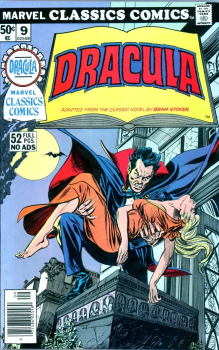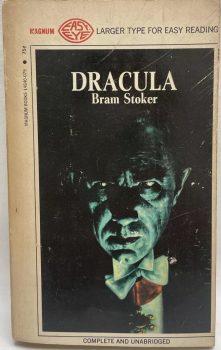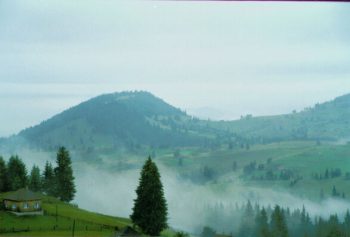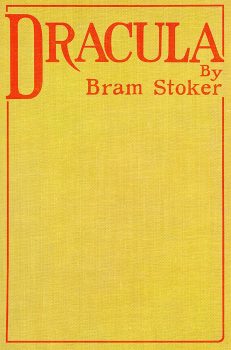Enter the Prince of Darkness:Dracula by Bram Stoker
“Listen to them—the children of the night. What music they make!”
Dracula to Jonathan Harker
I’ve heard tell my generation had nightmares about nuclear war, worried someone was going to press the big red button and trigger the annihilation of the world.
Not me. I was scared of vampires.
Heck, some nights I didn’t even have nightmares because I was too scared to sleep, convinced they were hiding behind the mottled sycamore trees that lined my block. I’m not sure where it came from. Probably from watching The Night Stalker TV movie (1972, dir. John Llewellyn Moxley) in which vampire Janos Skorzeny ravages sleazy seventies Las Vegas. It introduced the world to monster-hunter, Carl Kolchak and I saw it when I was seven or eight (thanks, Mom!). That fear disappeared quickly enough, but I was left with a taste for vampire stories.
I must have read some vampire stories in the various horror anthologies I bought regularly, though none spring to mind. I saw tons of movies and read stacks of horror comics featuring the bloodsucking fiends. It was two novels, though, that cemented my taste for the Central European monsters: Salem’s Lot (1975, Stephen King) and They Thirst (1981, Robert McCammon). They’re both big books, packed with characters and inventive takes on the idea of a master vampire trying to take over somewhere, a misbegotten Maine town in the first book and all of Los Angeles in the second.
In both books, vampires remain villains — undead monsters, wholly evil and merciless. I read Anne Rice’s 1976 novel, Interview With the Vampire and liked it sufficiently, but I suspect a lot of the sexual stuff went over my young head and I found the foppish Lestat and Louis less to my liking than King’s Kurt Barlowe and McCammon’s Prince Vulkan. Much later I read one or two of Brian Lumley’s bonkers Necroscope books and liked them well enough, but they’re more crazy adventure stories than vampiric horror. Somehow, though, I never read the ur-vampire novel, the book from which most of the movies and lore spring: Bram Stoker’s Dracula (1897).
Vampire and liked it sufficiently, but I suspect a lot of the sexual stuff went over my young head and I found the foppish Lestat and Louis less to my liking than King’s Kurt Barlowe and McCammon’s Prince Vulkan. Much later I read one or two of Brian Lumley’s bonkers Necroscope books and liked them well enough, but they’re more crazy adventure stories than vampiric horror. Somehow, though, I never read the ur-vampire novel, the book from which most of the movies and lore spring: Bram Stoker’s Dracula (1897).
I tried to read it as kid, courtesy of one of those Magnum Easy Eye large print books that sold in spinner racks at Woolworths, but I found it talky and dull. I did read the Marvel Classic Comics version from the seventies, probably the closest I got to the real thing, but pretty much, my relationship to the Count himself came by way of a seemingly endless supply of Universal and Hammer movies (and Sesame Street!). As is my usual reaction when I finally read something like Dracula, I have to kick myself for missing it for all those years.
 Bram Stoker was the business manager of London’s Lyceum Theatre and assistant to its great star and impresario, Sir Henry Irving. A friend later wrote that in writing, Stoker “had no higher aims” than to “sell” books. Dracula was his seventh published novel. His previous six books were an assortment of potboilers and romances and the next seven were largely supernatural or at least supernatural-adjacent. Save for Dracula, none are much read these days, and one, The Lair of the White Worm (1911) seems to have garnered some notices as one of the worst horror novels. Dracula, though, has never been out of print and secured Stoker’s name as the author of one the seminal works of horror fiction.
Bram Stoker was the business manager of London’s Lyceum Theatre and assistant to its great star and impresario, Sir Henry Irving. A friend later wrote that in writing, Stoker “had no higher aims” than to “sell” books. Dracula was his seventh published novel. His previous six books were an assortment of potboilers and romances and the next seven were largely supernatural or at least supernatural-adjacent. Save for Dracula, none are much read these days, and one, The Lair of the White Worm (1911) seems to have garnered some notices as one of the worst horror novels. Dracula, though, has never been out of print and secured Stoker’s name as the author of one the seminal works of horror fiction.
From his castle high in the Carpathian Mountains in Transylvania, Count Dracula has hatched a plot to leave his backward homeland and conquer new lands. In particular, he has set his blood-red eyes on London in all its glittering modernity. No more Székely henchmen stuck in their superstitious ways, but instead, yes, along with the occasional insane asylum patient, the count will rely on lawyers and real estate agents to set forth and bring England to its knees.
Jonathan Harker, a solicitor’s clerk, is sent to help arrange the purchase of a house near London for Dracula. Even before reaching Dracula’s castle, though, the poor Englishman soon realizes strange things are afoot in the dark forests and shadowy mountains of the Balkans. When he readies to board the coach that will take him toward his destination, the innkeeper’s wife implores him not to leave on such a dangerous night.
“It is the eve of St. George’s Day. Do you not know that to-night, when the clock strikes midnight, all the evil things in the world will have full sway? Do you know where you are going, and what you are going to?” She was in such evident distress that I tried to comfort her, but without effect. Finally she went down on her knees and implored me not to go; at least to wait a day or two before starting. It was all very ridiculous but I did not feel comfortable. However, there was business to be done, and I could allow nothing to interfere with it. I therefore tried to raise her up, and said, as gravely as I could, that I thanked her, but my duty was imperative, and that I must go. She then rose and dried her eyes, and taking a crucifix from her neck offered it to me.”
Harker is taken aback upon meeting his client for the first time, a man of wan complexion and dark attire.
Within, stood a tall old man, clean shaven save for a long white moustache, and clad in black from head to foot, without a single speck of colour about him anywhere. He held in his hand an antique silver lamp, in which the flame burned without chimney or globe of any kind, throwing long quivering shadows as it flickered in the draught of the open door. The old man motioned me in with his right hand with a courtly gesture, saying in excellent English, but with a strange intonation:—
“Welcome to my house! Enter freely and of your own will!” He made no motion of stepping to meet me, but stood like a statue, as though his gesture of welcome had fixed him into stone. The instant, however, that I had stepped over the threshold, he moved impulsively forward, and holding out his hand grasped mine with a strength which made me wince, an effect which was not lessened by the fact that it seemed as cold as ice—more like the hand of a dead than a living man.
Dracula, who never eats with Harker and whom, the young clerk later learns, appears to be the sole occupant as well as cook and servant in the castle, insists on learning as much as he can about England. Soon he’s insisting Harker remain in Transylvania and help him more thoroughly prepare himself for his emigration to the United Kingdom. Despite trying to resist, Harker finds himself writing letters to his employer and his fiancée, Mina, letting him know he’ll be staying a little longer. Then things get really weird and more than a little disturbing.
castle, insists on learning as much as he can about England. Soon he’s insisting Harker remain in Transylvania and help him more thoroughly prepare himself for his emigration to the United Kingdom. Despite trying to resist, Harker finds himself writing letters to his employer and his fiancée, Mina, letting him know he’ll be staying a little longer. Then things get really weird and more than a little disturbing.
And that’s all I’ll write about the plot of Dracula. At this point, you either know it from reading or cultural osmosis or you don’t. If you don’t, I do not want to deprive you of a spectacular late Gothic horror novel packed to the rafters with characters and incidents. There’s the Count, of course, as well as his castle, but there’s a zoöphagous madman, a despairing sea captain, and a delightful and steadfast doctor cum vampire expert.
With few real secrets to discover in Stoker’s novel, having had them revealed through all manner of comics, movies, and essays, I found much of my attention occupied with its intriguing construction. The first four chapters of Dracula are presented as Jonathan Harker’s diary. Beginning with the fifth, titled “Letters — Lucy and Mina”, we begin to gain different perspectives on the expanding story. Soon we have diary entries from both Lucy and Mina, the log of the doomed ship Demeter, and the diary of Dr. John Seward which includes, at one point, a phonographic recording by Dr Abraham Van Helsing. Additionally, there are newspaper excerpts and recorded conversations with witnesses to assorted strange events. Through these elements, Stoker tells his story through several different sets of eyes, none of which possess more than a part of the story until it is well on its way to its conclusion.
My favorite moment in the novel isn’t any of the horror bits, but a moment of meta-construction. As our heroes are preparing themselves for what they hope will be the showdown with Count Dracula (hint: it won’t be), the newly married Jonathan and Mina set themselves a task. To get the fullest picture of all the events that have led them to their current predicament, they collect all assorted diaries, letters, and articles and collate them into what is no less than the first half of the novel Dracula itself.
Later.—After lunch Harker and his wife went back to their own room, and as I passed a while ago I heard the click of the typewriter. They are hard at it. Mrs. Harker says that they are knitting together in chronological order every scrap of evidence they have. Harker has got the letters between the consignee of the boxes at Whitby and the carriers in London who took charge of them. He is now reading his wife’s typescript of my diary. I wonder what they make out of it. Here it is….
It’s a minor event, but I love it. How many authors of epistolatory novels bother to explain exactly how the reader has gotten hold of the disparate collections of bits and bobs in their hands?

Horror works best in the short form. It is often difficult, as so many authors insist on proving, to maintain any sort of atmosphere or mystery over something book-length. Stoker succeeded by essentially cheating. The first half of the book, whether concerned with Jonathan Harker’s sojourn in the Carpathians or the incident concerning Lucy Westenra, is firmly set in the horror camp and succeeds wickedly at portraying fright and despair in the characters and imparting more than a little of that to the reader.
Much of Dracula’s second half has the mien of a detective novel. The heroes must discover exactly what the count is planning, and once that’s done, how to counter his schemes. We’re treated to Harker and company scouring London and its environs with all the determination of Wilkie Collins’ Sergeant Cuff. They hunt down witnesses, follow leads, and even figure out how to break and enter without getting caught by the police. The whole thing whizzes along with increasing momentum as the vampire hunters attempt to defeat the ancient evil that has invaded the modern world in search of new blood.
During the book’s galloping finale, horror story and detective story come together as Dracula and the mortals hounding him make a dash for Castle Dracula. Both parties attempt to plot and out-plot the other as the novel’s attention returns to the haunted peaks of Transylvania.
As with Frankenstein a few years ago (review here), it was easy for me to appreciate the importance of Dracula and understand its longevity because it’s a darn good book. While the prose is only better than adequate, Stoker knew how to create an atmosphere of creeping dread as the stuff of folk tales invades London, the very apex of the modern world. Dracula is rarely on stage, being mostly portrayed as a behind-the-scenes manipulator, but the image Stoker presents of him as a semi-savage monster yet keen enough to experiment so as to expand his powers is brilliant. The scientific method that helped usher in modernity is the same vector that may return it to a time when men once again cower around the fire against the children of the night. The pacing rarely slackens and each chapter leaves the reader anxious to know what will happen next.
In Dracula, Bram Stoker did more than anyone else to solidify the modern conception of vampires. John Polidori’s “The Vampyre” (1819), “Varney the Vampire” (1845), and Sheridan LeFanu’s “Carmilla” (1872) were all important in popularizing the vampire in fiction and helping shed the shambling, rotting nature they had in folk tales. Still, Dracula is the single most important source for so many of the books and films in the following years. Of course, Bela Lugosi’s version in Tod Browning’s 1931 film, Dracula, is probably even more important, but it is derived from the book. ‘Salem’s Lot was deliberately written as an update of Dracula. Turning into wolves, bats, creepy locals, protective garlic, and stakes to the heart were all codified by Stoker’s book.
If, like me, you have failed to read Dracula, do yourself a favor and grab a copy (it’s free online from Project Gutenberg). October may be over, but autumn, with its ever-increasing nights, is the perfect time of year to lose yourself in this tale of ancient evil coming to new lands in search of better killing fields.
Dated and somewhat cheaply made, the BBC‘s 1977 Dracula remains the film version closest to Bram Stoker’s original novel. It scared the heck out of me as a kid.
Fletcher Vredenburgh writes a column the first Friday of the month at Black Gate, mostly about older books he hasn’t read before. He also posts at his own site, Stuff I Like when his muse hits him.

I liked the book, but I found the first part in Transylvania to be the best.
One thing about having multiple first person narrators is that it allows for the intimacy of first person while allowing that some one might die.
I wrote about the multiple narrators of Dracula (and two other horror stories) in a post for DMR books
https://dmrbooks.com/test-blog/2020/10/21/testaments-of-horror
It really is an absolutely ripping yarn. (I will also put in a good word for The Jewel of the Seven Stars, Stoker’s Egyptian horror novel – the middle drags a bit, but it opens and closes very strongly.) It’s a very neat trick giving us a big beginning dose of such a towering character, and then severely rationing his appearances for the rest of the book. I think it works beautifully.
That is the one book some critics liked, and it sounds pretty wild. As to Dracula off-stage, yeah, it’s daring, but making him a mysterious, largely unseen figure, definitely amps up the atmosphere of dread and fear.
Three cheers for the BBC “Dracula”, which restored a lot of the wonderful Gothic atmosphere to the story after many years of Universal’s modernizations and countless pastiches and parodies. Just delightfully weird and creepy, particularly my favorite sequence from the book involving Lucy Westenra and the “bloofer lady”.
I need to sit down and watch the whole thing. I remember being totally creeped out by the upside-down crawling scene and the ol’ baby in a bag scene when I watched it at 12 or so.
Yes, the ‘gift’ for the wives of a baby in a bag. Brrrr!
Unfortunately I found Louis Jourdan’s Count Dracula to be not very sinister and threatening at all. But I did enjoy the rest of the cast.
I bought my copy of Stoker’s novel from the Stoker Museum at Whitby on a UK visit a few years ago, after walking through the ruins of the abbey. Being a fan of the History Channel’s series “Vikings”, it was a double hit for me: being at an important setting in Stoker’s novel and also exploring what was left of the abbey believed to have been raided by the sons of Ragnar Lodbrok, the central character of the first few seasons of “Vikings”.